| Columns Retired Columns & Blogs |
Need that new Wallytractor!
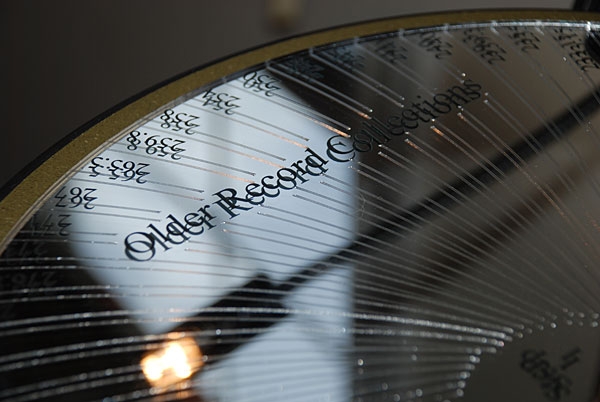
Two months ago, I ran out of space while covering the unsubtle sonic improvements of the passive CAD Ground Control system. Now that I've lived with the CAD for another couple of months, I can render my verdict: I can't live without it. After listening for weeks, I pulled it out of my system, listened for a few minutes, put it all back immediately, then wrote a check.
Inserting these passive boxes into the system resulted in a substantial increase in liquidity and tranquility, thanks to the removal of a layer of grit I didn't know was there. I've told a few friends about the CAD system and received thank-you notes in return. I don't know if the company offers a money-back guarantee, but even if they do, be prepared not to ask for a refund.
In other news: Next month, I'll revisit the fascinating Haniwa HCVC01 passive current-to-voltage converter (July 2020/Vol.43 No.7). I can't do it this month because I'm reviewing cartridges that work best with more standard and familiar phono preamplification.
A New WallyTractor
When WAM Engineering's Wally Malewicz passed away unexpectedly shortly after Munich High End 2018, the future availability of his excellent WallyTools, including the WallyTractor alignment gauge, seemed bleak. From what I'd been told, his son Andrzej—a mechanical engineer like his father but on an industrial, corporate scale—was interested but didn't have the time or resources to do it on his own. Fortunately, J.R. Boisclair, Wally's erstwhile production assistant, picked up the torch and, with Andrzej's help, produced a redesigned and improved WallyTractor, the "WallyTractor Universal." It's the first of several updated WallyTools to come off the assembly line (footnote 1).
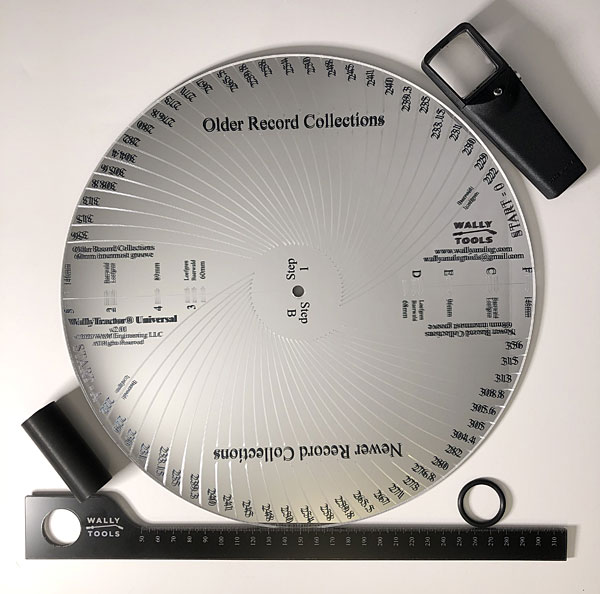
I first met Boisclair at a meeting of the San Francisco Audiophile Society in summer 2019. I'd been invited to speak and play some favorite records. He was there selling remaining stock of Wally-era WallyTools. When he told me about his plans for the new WallyTractor, I thought they seemed overly ambitious—but he has delivered, at least in phase one. I used the new WallyTractor ($395, available from wallyanalog.com) to set up the AMG Viella Forte Engraved turntable and 12JT tonearm reviewed elsewhere in this issue.
Like the original, the new WallyTractor features Baerwald and Löfgren A arcs laser-engraved on mirrored plexiglass for a variety of tonearm effective lengths, as well as a radius on which are inscribed sets of parallel lines at the two "null points" where tracking error is zero.
The new, round, LP-sized WallyTractor replaces the original wedge-shaped one, adding arcs for a wider range of tonearms—28 in all with effective lengths ranging from 222mm to 356mm, which should cover most if not all current, commercially sold arms. Mr. Boisclair told me that, should a buyer get an arm for which the gauge does not include its effective length, a "generous trade-in policy" will protect that investment.
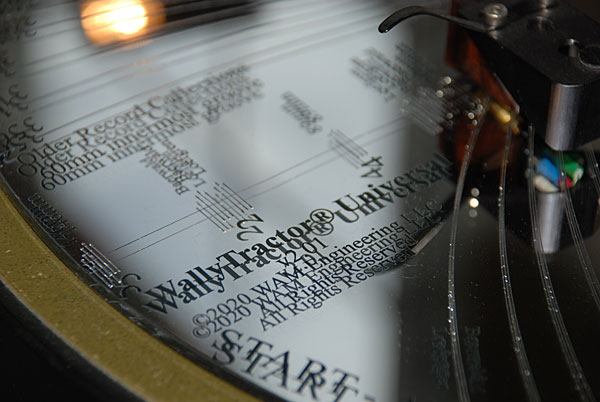
The new WallyTractor also adds a second set of arcs and another radius, for analogphiles with mostly newer record collections. Why does that matter? In the 1950s and '60s, the IEC (International Electrotechnical Commission) standardized values for the outermost (146.05mm) and innermost (60.325) record grooves. Record-cutting engineers don't always adhere to those specifications, but the numbers are mostly valid for older records, and they determine the preferred location of the two null points.
In preparation for designing the new WallyTractor, WAM took innermost- and outermost-groove measurements of "well over 1000" classical, rock, and jazz records made between 1950 and 2018 and found that post-1990 records show a significant increase in innermost groove radius: They're not cut as close to the label as pre-1990 records. They also found that nearly all 45rpm 12" reissues have an innermost groove radius larger than 68mm. WAM therefore recalculated the null points for the "newer records" arc. You can choose which ones to use depending on the makeup of your record collection. WAM claims that if your records are mostly post-1990 and/or are 12" 45s, using the "newer records" arc produces from a 9" arm distortion that's lower than that of a 12" arm with the old null points.
The WallyTractor also includes a useful, super-accurate pivot-to-spindle measuring device—see the photo on the previous page—and an illuminated 5× magnifying lens with an 8× bifocal feature (batteries not included).
The new WallyTractor is a versatile tool, extremely well-engraved—far superior to the already excellent original—and easier to read. The WallyTractor Universal is highly recommended for anyone who needs an easy-to-use, easy-to-read, universal alignment gauge. My only criticism: I wish the bottom surface was a little more grippy.
StylusTimer: a Turntable Odometer
A debate continues to rage about phono stylus lifetime, but if you don't know how many hours you've put on your stylus, the debate is moot: How do you even know when it's time to start fretting? StylusTimer can tell you when it's time to fret (footnote 2).
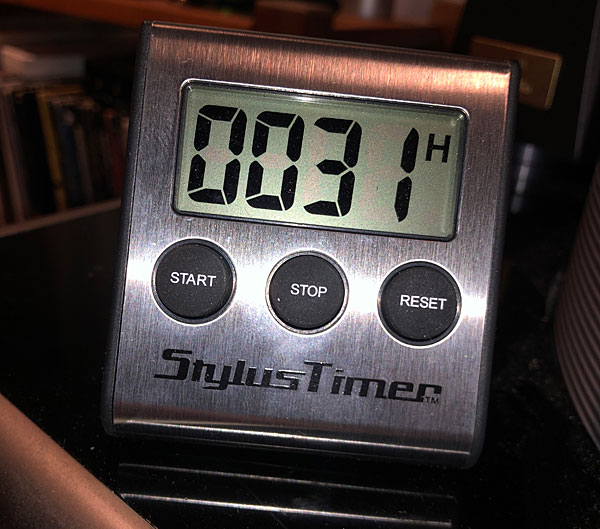
Resembling an ordinary kitchen timer, the StylusTimer is programmed to accumulate hours. Hit the "start" button and you'll hear a single beep. Hit "stop" and you'll hear two beeps. The beeps are needed because it only communicates hours, so for the first hour it appears not to be running. (I've heard from more than a few buyers asking what's wrong with their unit, until I remind them that it has to run for an hour before the "1" registers on the screen.)
The trick is to remember to start and stop it each time you lower and raise the stylus. It takes some training. If you leave it on accidentally and accumulate 12 overnight hours, you can make a note of it and subtract the difference or hit "reset" and start over again. It's important to get into the habit, but occasional errors shouldn't matter. Precision isn't needed for a device like this: It's enough to know whether you are at 100 hours or nearing 1000. Without the StylusTimer or a similar device—and I'm not aware of any similar, purpose-built devices—it's nearly impossible to keep tabs on the hours.
I have found StylusTimer really useful. It keeps its memory when you change the single AAA battery. (I've not had to do that yet, after many months of use.) If you often swap out cartridges, as I do, pick up a few StylusTimers and label them. At $19.95 each including shipping, it's an inexpensive, worthwhile investment.
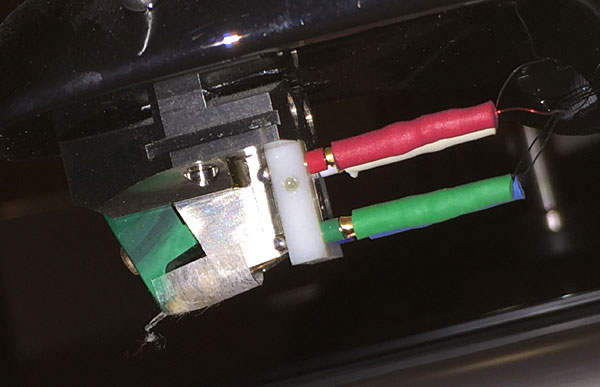
As for how long a stylus lasts before it needs replacing, that in great part depends upon how clean you keep it and your records. Your stylus may look clean to the naked eye, but still, on a microscopic level, look like the one in the photo. (The person who owns the cartridge pictured on the above, who shall remain nameless, thought his stylus was clean until I looked at it with a microscope.) That dust ball acts like sandpaper in the grooves, damaging the stylus and the record. Add oil from your fingers and stylus-generated heat, and it's a recipe for premature stylus and record wear.
Generally speaking, starting at around 800 hours on a "severe" stylus profile (Replicant, Geiger, van den Hul, Shibata, and so on), you'll hear a loss of detail and smearing and softening of transients. It sneaks up so gradually, though, that you might not notice it. By 1000 hours, it's time for a retip or a cartridge upgrade. The StylusTimer, when used as directed, will let you know when it's time for a change.
The Fuuga MC Phono Cartridge, Revisited
Speaking of listening and remembering, I'm revisiting the Fuuga MC cartridge I covered in Vol.38 No.10, because I forgot I'd already reviewed it—though it is anything but a forgettable cartridge. It has been almost 5 years since I wrote "Fuuga is, without a doubt, among the handful of highest-performing, most-enjoyable cartridges I have heard," although I still don't remember writing that (footnote 3).
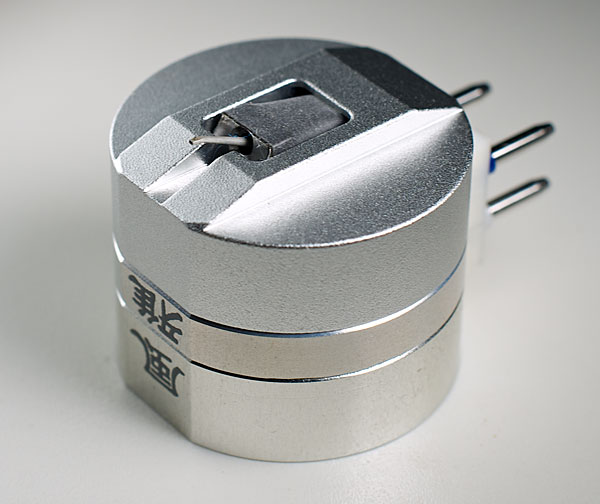
The Fuuga was kindly sent by designer Osamu Nagao, to whom I'd been introduced by Lyra cartridge designer Jonathan Carr earlier in the year at the Tokyo International Audio Show. In an email, Carr provided the rich backstory of the Fuuga and its designer.
Footnote 2: Stylus Timer, Web: stylustimer.com
Footnote 3: Fuuga MC Cartridge are imported by Audioarts, 210 Fifth Avenue, New York, NY 10010. Web: audioartsnyc.com.

Need that new Wallytractor!

I have an older Wallytractor that was made for my "FrankenRega" P3 2000 (Groovetracer Reference Subplatter, Heavyweight dropped counterweight, Incognito re-wire, Rega white belt). Yeah, I should have just bought a better TT but I enjoy futzing around with upgrades over time. Anyway, most of my records are pre-1990 rock and jazz and I used the Baerwald alignment. Would Loefgren make more sense?

..... you lower and raise the stylus. It takes some training."
"It's enough to know whether you are at 100 hours or nearing 1000." quoted M. Fremer.
Are we asking for trouble?
So what if the timer tells me my stylus has already tasked 1,000 hours as long as it still tracks properly?
I would spend on something else more practically useful: a 3-digit stylus pressure gauge. I measure the stylus pressure of my MM cartridge from time to time: 1.15 gram.
Whatever precision tone arm/catridge tractors is not my concern despite I own & play my 1,000+ stereo LPs. I don't need one as I test from time the tracking of my tonearm/cartridge on the GROOVELESS track of my test record to make sure it stays stationary on the spinning grooveless track.
FYI, some years back, the left channel of my SME black fibre tone arm/detacheable headshell got no sound due to the finer-than-hair signal wire inside the tonearm tube broken. I took out the tonearm, complete dismantled the whole tonearm & replaced the 4 signal wires with very fine super fast computer graded silver plated oxygen-free pure copper wires. I reinstalled the expensive black SME tonearm WITHOUT any whatever tractors. I tested my 'reinvented' SME tonearm on my grooveless
test record - it works flying colour !
Knowledge is a tool to save money !
Jack L

Why one would buy a WallyTractor and not a SmartTractor? I have the Wally and I like it, BUT if you have a tonearm with an effective length that is not in the Wally you are out of luck.
Can anyone explain this for me? I am not trying to talk the Wally down, but understand what are the pros and cons of the Wally